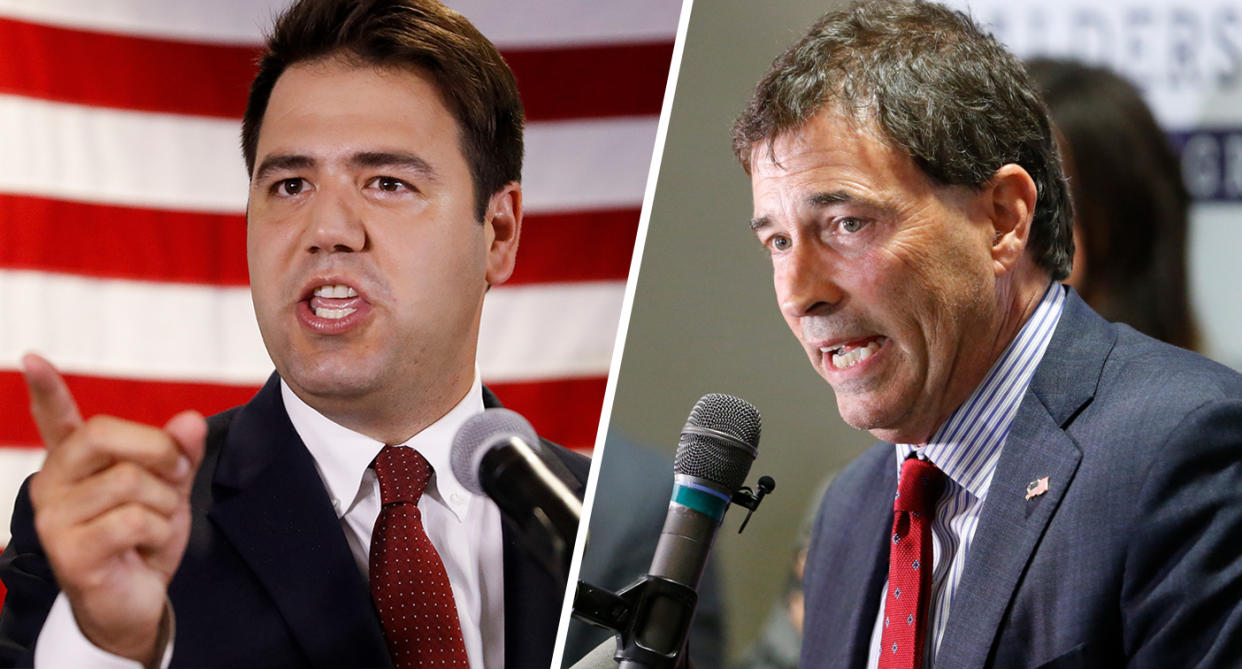Midterm Mania No. 1: Why Democrats and Republicans should worry about the Ohio results


Top Story:
Tuesday was primary day in Michigan, Missouri, Kansas and Washington state. Key takeaways included surprisingly strong showings from Democratic House challengers in Washington; disappointing news for Alexandra Ocasio-Cortez-style progressives across the Midwest; and notable strides for labor and women.
But more on those contests later.
This week’s marquee event was the special election to replace former GOP Rep. Pat Tiberi in Ohio’s 12th U.S. House District, encompassing the Columbus suburbs and surrounding area — and both Democrats and Republicans have reason to be encouraged and discouraged by the results.
At press time, Republican Troy Balderson appears to have edged out Democrat Danny O’Connor by 1,754 votes, or 0.9 percentage points. For some news outlets, the race remains too close to call; after all, they argue, there are still thousands of provisional and absentee ballots left to count — perhaps more than 8,400.
But most analysts agree that O’Connor is unlikely to catch up.

So Republicans should be rejoicing and Democrats should be crying into their iced almond lattes, right? Well, sort of. With a 22-seat House majority and a full 60 seats at risk in November, Republicans really can’t afford to lose any more special elections — especially in districts like the traditionally conservative OH-12, which voted for Donald Trump by 11 percentage points in 2016. Ohio operatives considered Balderson, a state senator, an “underwhelming candidate.” He and O’Connor were tied in the polls heading into Tuesday. And so a win is a win is a win.
Still, if ever a victory could be tempered with foreboding, Balderson’s would be it. For one thing, national Republicans had to ride to Balderson’s rescue. Congressional Leadership Fund, the top House GOP super-PAC, spent $3.2 million on the race; the National Republican Congressional Committee spent another $1.3 million. Overall, Republicans outspent Democrats five-to-one. Both Trump and Vice President Mike Pence came to Ohio and campaigned on Balderson’s behalf. All of which, it’s worth noting, was only possible because there weren’t 434 other congressional elections happening on the same day. In November, the Baldersons of the world won’t be receiving that kind of attention from the White House.
And Balderson himself may be among them. If he does end up assuming Tiberi’s seat in Congress, he will only have a lock on it for three months — the remainder of the term Tiberi resigned from earlier this year. At that point, Balderson will face off against O’Connor for a second time, on Nov. 6, to decide who will represent OH-12 in the next Congress.
Some experts say Balderson will have the advantage of incumbency this fall. But that’s unclear at best. O’Connor, a baby-faced 31-year-old county official, proved on Tuesday that he could come within a single percentage point of winning a district that leans Republican by 14. That should make him a magnet for Democratic resources in the coming rematch, and it should give hope to Democratic challengers elsewhere — several dozen of whom will be competing in districts far less red than OH-12.
Verbatim:

Best of the Rest:
Washington: While most political junkies were obsessing over Ohio, Tuesday’s truly head-turning results may have been rolling in thousands of miles away. Like California, Washington state has a nonpartisan “jungle” primary system, which means Democrats and Republicans compete against each other and the top two finishers advance to the general election regardless of party affiliation. So while mail-in votes are still being tallied, it’s already obvious, with about two-thirds of the count completed, that Republicans had a bad night.
Democrats knew they’d be competitive in Washington’s GOP-held Eighth Congressional District, an exurban and rural area straddling the Cascade Mountains, where three-time statewide Republican candidate Dino Rossi is running to succeed retiring GOP Rep. Dave Reichert — so they were encouraged Tuesday to discover that Rossi and the two other, minor Republicans combined for just 47 percent of the vote, or 10 points less than Reichert’s vote share in the primary two years ago. Democratic candidates, meanwhile, won half the votes, meaning that whoever ends up as their nominee — either pediatrician Kim Schrier or attorney Jason Rittereiser — will enter the fall contest in very good shape.

What Democrats didn’t necessarily expect, however, was to put two other GOP-held seats on the map: 1) WA-03, in the state’s southwestern corner, where Democrats combined for 50.3 percent of the vote and local college professor Carolyn Long currently lags a mere four points behind incumbent Jaime Herrera Beutler, who has only barely managed to clear 40 percent, and 2) WA-05, on the state’s easternmost edge, where Democratic challenger Lisa Brown is within 600 votes of seven-term Republican incumbent Cathy McMorris Rodgers, the only woman in House GOP leadership. Both seats will now be seen as prime Democratic pickup opportunities.
Kansas: Most Kansas coverage focused on the GOP gubernatorial primary, which pitted incumbent Gov. Jeff Colyer against Kansas Secretary of State Kris Kobach. The race was billed as yet another round in the ongoing battle between so-called establishment Republicans and Trumpian insurgents, with Colyer in the establishment role (he assumed the governorship in January when his unpopular predecessor Sam Brownback accepted a religious ambassador appointment from Trump) and Kobach in Trump’s corner (he is best known for vice chairing President Trump’s controversial voting commission and helping to author anti-immigration legislation).
So which side won? We don’t know yet. Kobach currently leads by fewer than 200 votes, and provisional and mail-in ballots are continuing to trickle in. Many Republican may be rooting against Kobach, however: A mid-July poll showed Colyer leading Democratic nominee Laura Kelly by 10 points — and Kobach trailing her by one.

Down ballot, the most interesting question Tuesday was whether the newly emboldened Bernie Sanders–Alexandra Ocasio-Cortez Democratic Socialist wing of the Democratic Party could connect with prairie Democrats. They found some success in KS-04, around Wichita. There, Sanders and Ocasio-Cortez campaigned for James Thompson, who wound up easily winning Tuesday’s primary. Unfortunately, KS-04 leans Republican by 15 percentage points, making Thompson the longest of general-election long shots.
More telling, perhaps, was the outcome in the suburban swing district KS-03, around Kansas City, where Sharice Davids, an LGBTQ Native American attorney and former MMA fighter, defeated Brent Welder, a former Bernie Sanders staffer who ran on Medicare for All. Sanders and Ocasio-Cortez campaigned for Welder as well, but it wasn’t enough. In November, Davids will face off against incumbent Republican Kevin Yoder, who captured only 68 percent of the GOP vote in Tuesday’s primary — a weak showing that convinced the Cook Political Report to move his reelection race from “Lean Republican” to “Toss Up.”
Michigan: In terms of intraparty Democratic dynamics, it was more of the same in the Wolverine State, where Sanders and Ocasio-Cortez attempted in the closing weeks to boost young, progressive physician Abdul El-Sayed for governor — but where El-Sayed wound up finishing nearly 20 points behind former state Sen. Gretchen Whitmer in Tuesday’s primary.
Whitmer’s victory does, however, reflect a larger 2018 trend: the rise of women gubernatorial candidates. So far this year, a record 11 women have been nominated for governorships, including Democrat Laura Kelly, a Kansas state senator who also won her primary Tuesday. As the New York Times put it, this is “a breakthrough in a political arena … that has been especially unfriendly to women in the past”: executive offices.
Meanwhile, in the heavily Democratic 13th District, which includes parts of Detroit and its suburbs, former state Rep. Rashida Tlaib, who likened herself to Ocasio-Cortez, won the Democratic primary and is expected to become the first Muslim woman elected to Congress.
Verbatim:

Trump Factor:
On Tuesday night and Wednesday morning, Trump went on a Twitter tear, pointing out that his endorsed GOP candidates — Josh Hawley for Missouri senator, Bill Schuette for Michigan governor, John James for Michigan senator, Troy Balderson for Ohio congressman, and Lena Epstein for Michigan congresswoman — had gone “5 for 5!,” proving that “as long as I campaign and/or support Senate and House candidates (within reason), they will win.”
“RED WAVE!” Trump added in a separate tweet.
Does the president have a point? In one sense, yes: He is clearly a force to be reckoned with in Republican primary contests (though it remains to be seen whether the candidate who needed his help the most, Kansas’s Kris Kobach, can eke out a victory).
But there were also signs Tuesday that when it comes to the broader, more consequential context of a general election, Trump may wind up doing his party more harm than good.
Ohio is key here. The 12th Congressional District, centered on the Columbus suburbs, is well-educated and white — and it has long voted for Republicans. In 2016, however, Trump performed worse among college-educated, higher-income suburbanites than any Republican in recent memory, and since then, his aggressive, divisive approach has only reinforced their doubts.

On Tuesday, that antipathy registered at the ballot box: Balderson finished 22 percentage points behind his Republican predecessor (Tiberi) in suburban Franklin County and 18 percentage points back in suburban Delaware County; turnout, meanwhile, rose to 42 percent in Franklin and Delaware, but languished between 27 and 32 percent in the more rural parts of the district.
This suggests that the wealthiest, most-educated elements of the OH-12 electorate — the elements most uncomfortable with Trump — showed the most interest in voting and voted much more Democratic than they have in the past. In a year when Republicans are defending dozens of seats that look a lot like OH-12 demographically but that tend to be a lot less pro-Republican in their partisan leanings — seats from Kansas to California to Minnesota — Tuesday’s data from the Columbus suburbs represent a warning sign about Trump’s impact come November.
Up Next:
August 11: Hawaii primaries
August 14: Connecticut, Minnesota, Vermont, Wisconsin primaries
_____
Read more from YahooNews:



